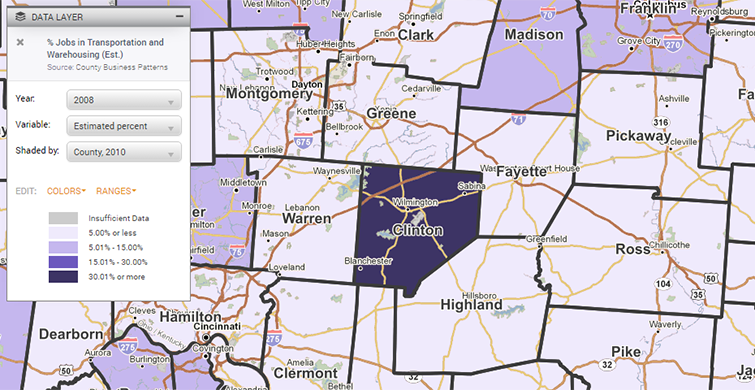Stories Behind Data: Clinton County Catastrophe

 Often when we think of disasters we think of environmental disasters. But economic disasters can also devastate a community. These disasters often take the form of a giant spike in the unemployment rate. Few counties understand this better than Clinton County, Ohio, a county that was devastated by the closing of its biggest employer in 2009. While the county was recovering in 2013, I was an intern for its Chamber of Commerce and I learned about the county’s story from the local residents. I will use PolicyMap’s economic data to tell the story.
Often when we think of disasters we think of environmental disasters. But economic disasters can also devastate a community. These disasters often take the form of a giant spike in the unemployment rate. Few counties understand this better than Clinton County, Ohio, a county that was devastated by the closing of its biggest employer in 2009. While the county was recovering in 2013, I was an intern for its Chamber of Commerce and I learned about the county’s story from the local residents. I will use PolicyMap’s economic data to tell the story.
Right before the disaster in 2009, Clinton County’s workforce was heavily concentrated in the transportation and warehouse industry. In 2008, according to the Census Bureau, over 40% of Clinton County’s jobs were in the transportation and warehousing industry. No county in Ohio had similar levels of concentration in this industry. In fact, the county ranked second in terms of percentage of its workforce in this industry in the United States. It was safe to say that when the transportation and warehousing industry does not do well, the Clinton County workforce will not do well.
Click here to interact with map.
In 2009, disaster hit. The transportation and warehousing industry suffered massive job losses. One of the industry’s major employers, DHL Express, closed its distribution hub in Clinton County and laid off over 8,000 workers. In the months following the hub’s closing, unemployment climbed up to a Great Depression-like rate of 20.1%, leaving one-fifth of the labor force out of a job!

From 2010 to 2013, the disaster left economic wreckage on the county’s economy. Thousands of workers had lost the income they spend on the goods and services of businesses in the Clinton County economy. Businesses lost profits and needed to save money. So these business laid off their own workers. That increased the county’s unemployment rate to levels above the state average unemployment rate.
Clinton County responded to this disaster with a combination of government policies and grassroots organizing. Residents organized community development campaigns such as a Buy Local First campaign, encouraging people to spend money on local goods and services to support the local economy. The county government lowered taxes and improved local infrastructure to support business development.
Now, the Clinton County economy is recovering from the trauma and is stronger. The county’s unemployment rate has fallen to the state unemployment rate. The county’s workforce is no longer concentrated in the transportation and warehousing industry or in any particular industry for that matter. According to the county’s Chamber of Commerce Director Mark Rembert, companies from a variety of industries like Ahresty (auto manufacturing) and Alkermes (pharmaceutical) have been expanding and hiring workers. Clinton County is making a comeback.



